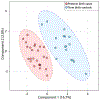Metabolites from midtrimester plasma of pregnant patients at high risk for preterm birth
- PMID: 33991707
- PMCID: PMC8555706
- DOI: 10.1016/j.ajogmf.2021.100393
Metabolites from midtrimester plasma of pregnant patients at high risk for preterm birth
Abstract
Background: There is an increased awareness regarding the association between exposure to environmental contaminants and adverse pregnancy outcomes including preterm birth. Whether an individual's metabolic profile can be utilized during pregnancy to differentiate the subset of patients who are ultimately destined to delivered preterm remains uncertain but could have MEANINGFUL clinical implications.
Objective: We sought to objectively quantify metabolomic profiles of patients at high risk of preterm birth by evaluating midtrimester maternal plasma and to measure whether endogenous metabolites and exogenous environmental substances differ among those who ultimately deliver preterm compared with those who deliver at term.
Study design: This was a case-control analysis from a prospective cohort of patients carrying a singleton, nonanomalous gestation who were at high risk of spontaneous preterm birth. Subjects with a plasma blood sample drawn at <28 weeks' gestation and no evidence of preterm labor at the time of enrollment were included. Metabolites were extracted from frozen samples, and metabolomic analysis was performed using liquid chromatography/mass spectrometry. The primary outcome was preterm birth at 16.0 to 36.9 weeks' gestation.
Results: A total of 42 patients met the inclusion criteria. Of these, 25 (59.5%) delivered preterm at <37 weeks' gestation, at a median of 30.14 weeks' gestation (interquartile range, 28.14-34.14). A total of 812 molecular features differed between preterm birth cases and term controls with a minimum fold change of 1.2 and P<.05. Of these, 570 of 812 (70.1%) were found in higher abundances in preterm birth cases; the other 242 of 812 (29.9%) were in higher abundance in term birth controls. The identity of the small molecule/compound represented by the molecular features differing statistically between preterm birth cases and term controls was identified as ranging from those involved with endogenous metabolic pathways (including lipid catabolism, steroids, and steroid-related molecules) to exogenous exposures (including avocadyne, diosgenin, polycyclic aromatic hydrocarbons, acetaminophen metabolites, aspartame, and caffeine). Random forest analyses evaluating the relative contribution of each of the top 30 compounds in differentiating preterm birth and term controls accurately classified 21 of 25 preterm birth cases (84%).
Conclusion: Both endogenous metabolites and exogenous exposures differ in maternal plasma in the midtrimester among patients who ultimately delivered preterm compared with those who deliver at term.
Keywords: endogenous metabolic pathways; environmental exposures; exogenous exposures; metabolomics; preterm birth.
Copyright © 2021. Published by Elsevier Inc.
Conflict of interest statement
The authors report no conflict of interest.
Figures




References
-
- Marret S, Ancel PY, Marpeau L, et al. Neonatal and 5-year outcomes after birth at 30–34 weeks of gestation. Obstet Gynecol 2007;110:72–80. - PubMed
-
- Bhutta AT, Cleves MA, Casey PH, Cradock MM, Anand KJ. Cognitive and behavioral outcomes of school-aged children who were born preterm: a meta-analysis. JAMA 2002;288:728–37. - PubMed
-
- Wolke D, Eryigit-Madzwamuse S, Gutbrod T. Very preterm/very low birthweight infants’ attachment: infant and maternal characteristics. Arch Dis Child Fetal Neonatal Ed 2014;99:F70–5. - PubMed
-
- Gotsch F, Gotsch F, Romero R, et al. The preterm parturition syndrome and its implications for understanding the biology, risk assessment, diagnosis, treatment and prevention of preterm birth. J Matern Fetal Neonatal Med 2009;22(Suppl2):5–23. - PubMed
Publication types
MeSH terms
Substances
Grants and funding
LinkOut - more resources
Full Text Sources
Other Literature Sources
Miscellaneous

